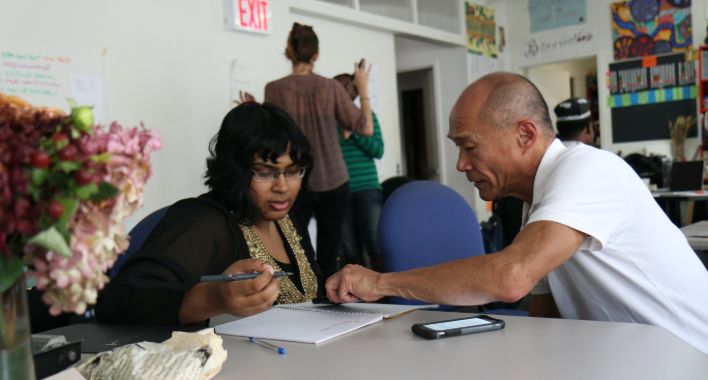Some companies are bridging the generation gap in the workplace through explicit recruitment policies. According to this strategy, it is an attempt to select people of a specific age range -not very wide- to maintain the desired balance in the team. At other times, there is no clear guideline in this respect. Still, the organization’s inertia means that the age range of the employees is narrow, i.e., there is little difference between the age of the most senior members and that of the youngest.
However, it is challenging to keep the generation gap in the workplace to a minimum for long, especially as companies grow and their needs become more complex. Moreover, suppose the company operates appropriately and has a good talent retention policy. In that case, its replacement rate is likely to be low: people tend not to leave the company and, therefore, many employees are “aging” within the company while watching the arrival of people somewhat or much younger than themselves.
How to interpret the generation gap in the workplace
We live in an era that tends to sanctify the ideas of youth, novelty, and generational change. Age also manifests itself with great intensity in the world of work: we find new faces in younger faces, which are assumed to be “over-prepared.”
We praise new talent because it is good “just” because it is new. This may be true on many occasions: time, experience, and the different circumstances that shape people’s lives cause them to burn out and become outdated in their knowledge and skills. Therefore, companies need to complement them, if not replace them, with younger teams, leading to generation gap issues in the workplace.
The truth is that work is not viewed the same way the first day you arrive at the office compared to five or ten years after you join the company. Nor is it the same when you are 25 years old compared to 40 or 50. Of course, the first important job you have is not the same as the third or fourth.

The employees that time has turned us into
Whether we have little or a lot of work experience or life experience, we are the employees we are at any given moment. We are also, at each moment, the employees that time has turned us into.
Age, that is, time and what we do with that time (or, in other words, time and what happens to us during that time) significantly shape us as individuals at all levels. Of course, also at a professional level.
Some people find it more challenging to learn and mature in various aspects as if time does not provide them with experience. But rather a vain repetition of behaviors that make them similar to their younger peers when, in fact, the experience should have already begun to separate them from them.
However, most people can feel the passage of time on them in a more positive way: age is not always golden, but it usually gives rise to a specific capacity for temperance, to relativize the good and the bad, to balance one’s strengths and forge relationships more stably, also at work.
Been there
Working with people born when you were starting university or sharing a team with people who are your parents’ age may not be the most relevant issues in company life. Still, they have an importance that is worth taking care of to make it work in favor of the organization.
This type of generation gap in the workplace can significantly influence how we relate to certain colleagues:
- Who we seek to protect us
- Who we seek to protect or advise as if they were our younger siblings
- Who understand us better or worse
Or also negatively: those who awaken in us the same negative affections or distrust as other figures in our social environment who are of the same age.
Join the global leading solution in mental well-being
How do generational differences affect the workplace?
1. Avoid generational gaps
In principle, there is nothing wrong with the age of a company’s members being very diverse or not very diverse. Companies do not necessarily have to put together teams of young, mature, or of widely varying ages, but rather the teams that are best suited to achieve their objectives.
However, as we have mentioned, as the company grows, it is more likely that generational differences will emerge, leading to a generation gap in the workplace.
This means that the workforce is not cohesive because age is a factor that separates people. No doubt about it: this will eventually harm the work environment. HR managers must pay attention to this risk and focus on bridging the generation gap in the workplace.
2. Avoid age stereotypes
That is, learning to identify and counteract our prejudices associated with people belonging to different generations.
The two virtues usually associated with older people are experience and maturity. Experience in this particular job, in other positions, in life, is like having a degree. However, it is also true that some people have not known or wanted to take advantage of their time and do not provide more value just because they have been doing the same thing for more years.
As for emotional maturity, would take the form of temperance, self-confidence, caution, interpersonal intelligence, the ability to regulate oneself, and provide support and encouragement to other colleagues, especially those who are younger. Do we gain this with age? Yes, as long as we are not driven by disbelief, frustration, bitterness, or distrust of everything that does not belong to our world.
As for younger employees, they are often valued for connecting with the most immediate reality through their use of non-traditional means of communication and a highly updated education. Social media and mobile apps predominantly mediate their lifestyle much more intensely than their older co-workers. Is this a virtue? It will depend on the job to be performed and the person behind those uses.
Moreover, young people are also credited with greater flexibility, openness, and lack of vices acquired over time. However, does the lack of years ensure that the person will have these qualities? No, so it is crucial to examine them based on age parameters to gauge their true worth as an employee.

There is no ideal age for a team
It is all about combining and drawing on personal characteristics (soft skills) that bridge the generation gap in the workplace.
Speaking the same language or living in the same city does not ensure that communication between co-workers will be as effective as possible. When we are ten, fifteen, or even thirty years apart in age, we can interact by sharing basic codes, but that does not ensure that we understand each other so that our work and relationships are as good as they should be.
The reason is that our habits, lifestyles, social environments, ways of expressing ourselves, responsibilities, etc., may be very different. There is a significant risk that this may separate us, hindering communication and the bonds of trust, collaboration, or admiration that are so nourishing for the work environment.
Therefore, it is necessary to take care of the harmonization of languages, rhythms, knowledge, and references. Ultimately, it is required to put all this mix at the service of productivity: to make good team cohesion possible with people from very different worlds because of their ages.
Emotional well-being program for companies
At ifeel, we know that work should not disrupt people’s well-being. That is why our team of psychologists, experts in well-being at work, has created an emotional well-being program for companies that positively impacts talent retention, reduces absenteeism, and combats employee stress.
In our Resources section, you will find helpful material, such as podcasts, HR guides, or interviews with HR managers. In addition, we have a Psychosocial Risk Factors Template, which you can use to comply with the requirements of the Labor Inspection.
Thanks to our emotional well-being program, your company’s HR managers can receive personalized, data-driven advice on improving the psychological well-being of their teams. In addition, this program offers employees a 360° mental health care service structured at different levels according to their needs. Try our program today to see how it could help you.
We hope you found this post about the generation gap in the workplace interesting. If you would like more information about our emotional well-being program for companies, request it, and we will contact your team as soon as possible.









